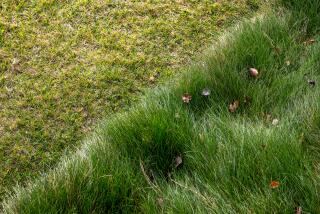Lawn Ornaments: A Romp in the Grass Menagerie
- Share via
A lawn without a lawn ornament is like a duck without galoshes--functional, but not really arresting. Few humans can resist the urge to personalize undifferentiated space. And ever since the grand lawn ornaments of antiquity--Stonehenge, the Pyramid of Khufu, the Easter Island heads--our yard embellishments have combined individual expression with prevailing values.
For Americans, says anthropologist Pamela Frese of Wooster College in Ohio, that means ornaments depicting our “utopian mythology”--notably the “dialectic between wilderness and civilization” that “motivates and validates American culture.”
Unhappily, no formal typology exists. But the following may aid in classifying the more common motifs:
--Pastoral Intensifiers. This group, which includes the justly esteemed lawn flamingo, links the lawn with various aspects of the wilderness, depending on the individual’s psycho-symbolic need. It takes three principal forms.
The Entire Plaster Cast
The Neo-Leprechaun set (common among those who think Willard Scott actually causes the weather) constitutes a non-threatening allusion to primordial animist views of nature and includes the entire plaster cast of lawn elves, simpering trolls and other rustic deviants.
The second, or Kilimanjaro, genre appeals to those trying to suffuse their yard with the brute mystery and menace of the gore-splattered wild, so that a stroll out to the Super Can is tantamount to hunting for King Solomon’s mines. Thus the grass menagerie of elephants, rhinos and turf tigers.
The third, or Unca Walt Cluster, expresses the opposite: the yearning to reduce nature’s little felons to manageable humanoid cartoons. To wit: anthropomorphic frogs sitting up with their legs crossed, enormous cheerful rodents holding stylized acorns and cement bears wearing dust ruffles.
Hardy Perennials
--Religious Icons. Statues of the Virgin Mary, St. Francis and St. Fiacre (patron saint of gardening) are hardy perennials. Sometimes they are combined with secular emblems, as in the ingenious “bathtub Madonna,” achieved by burying an old claw-foot bathtub vertically in the earth with half left sticking out. The resulting arch is ideally suited to a shrine and impervious to the elements, and the faucet holes can be fitted with lights.
--Rural-Nostalgic Alluders. Plows, wells with bucket and pulley and the ever-popular half-buried wagon wheels are an attempt to recapture our agrarian past, imbuing yard and owner with a sodbuster elan. Some scholars argue that such displays originated in the migration from soil to city, as a way for former farmers to retain and glorify a vestige of their agricultural heritage. Never mind that the soul-sapping drudgery these emblems represent probably caused their original users to flee the farm in the first place.
--Status Escalators. Up-and-coming areas are prone to what Frese calls “democratized elite forms of estate decoration.” Hence the ubiquity of plaster lion pairs (the sort you see flanking the gateway entrance to your statelier abodes), neoclassical statuary and pedestaled “gazing balls”-- the last of which, according to folk magic, repel witchy women who might imperil a young bride’s love nest. But neighborhoods that are already upscale also have status yearnings. In the better burbs, says Betty Pohlen, owner of Old World Lawn Products in Beltsville, Md., the “biggest items right now are fountains.” Thanks to hydraulic one-upmanship, “They’re starting to ask for bigger and bigger ones all the time.”






